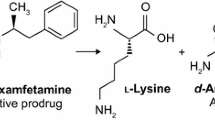Abstract
Rats were trained to discriminate between two levers utilizing drug-induced physiological states as discriminative stimuli. Drug injections were associated with reinforcement of response on one lever and saline was associated with reinforcement on the other lever. At equimolar doses, d- and l-amphetamine but not para-hydroxyamphetamine, functioned effectively as cues. Following training, stimulus generalization between these drugs was evaluated. Transfer of response control was observed between the d- and l-isomers, and between para-hydroxyamphetamine and saline in rats trained to utilize d- or l-amphetamine versus saline as cues. These findings suggest the importance of central pharmacological activity in this type of response control.
Similar content being viewed by others
References
Barry, H., Kubena, R. K.: Discriminative stimulus characteristics of alcohol, marihuana and atropine. In: Drug Addiction: Experimental Pharmacology. J. M. Singh, L. H. Miller, and H. Lal, Eds., Vol. 1, pp. 3–16. Mount Kisco, New York: Futura Publ. Comp. 1972
Brodie, B. B., Cho, A. K., Gessa, G. L.: Possible role of p-hydroxynorephedrine in the depletion of norepinephrine induced by d-amphetamine and in tolerance to this drug. In: Amphetamine and related compounds. E. Costa and S. Garattini, Eds., pp. 217–230. New York: Raven Press 1970
Brown, A., Feldman, R. S., Moore, J. W.: Conditional discrimination learning based upon chlordiazepoxide: Dissociation or Cue? J. comp. physiol. Psychol. 66, 211–215 (1968)
Clay, G. H., Cho, A. K., Roberfroid, M.: Effect of diethlyaminoethyl diphenyl-propylacetate hydrochloride (SKF-525A) on the norepinephrine depleting actions of d-amphetamine. Biochem. Pharmacol. 20, 1821–1831 (1971)
Conger, J. J.: The effects of alcohol on conflict behavior in the albino rat. Quart. J. Stud. Alcohol 12, 1–29 (1951)
Costa, E., Naimzada, M. K., Revuelta, A.: Pharmacological implications of the effects of amphetamine and its analogs on the turnover rate of tissue catecholamines. In: Brain chemistry and mental disease: Advances in behavioral biology. B. T. Ho and W. M. McIsaac, Eds. Vol. 1, pp. 83–96. New York: Plenum Press 1971
Harris, R. T., Balster, R. L.: An analysis of the function of drugs in the stimulus control of operant behavior. In stimulus properties of drugs. T. Thompson and R. Pickens, Eds., pp. 111–132. New York: Appleton-Century-Crofts 1971
Hill, H. F.: Evidence that amphetamine hyperthermia is produced by an action of the drug on the CNS. Fed. Proc. 30, 206 (1971)
Innes, I. R., Nickerson, M.: Drugs acting on postganglionic adrenergic nerve endings and structures innervated by them (sympathomimetic drugs). In: The Pharmacological basis of therapeutics. L. S. Goodman, and A. Gilman, Eds., 4th edit., pp. 478–523. New York: The McMillan Comp. 1970
Kilbey, M. M., Harris, R. T., Aigner, T. G.: Establishment of equivalent external and internal stimulus control of an operant behavior and its reversal. Proceedings, 79th Annual Convention, A.P.A., op. 767–768 (1971)
Kubena, R. K., Barry, H.: Two procedures for training differential responses in alcohol and non drug conditions. J. pharm. Sci. 58, 99–101 (1969a)
Kubena, R. K., Barry, H.: Generalization by rats of alcohol and atropine stimulus characteristics to other drugs. Psychopharmacologia (Berl.) 15, 196–206 (1969b)
Kubena, R. K., Barry, H.: Stimulus characteristics of marijuana components. Nature (Lond.) 235, 397–398 (1972)
Lewander, T.: Displacement of brain and heart noradrenaline by p-hydroxynorephedrine after administration of p-hydroxyamphetamine. Acta pharmacol. (Kbh.) 29, 20–32 (1971a)
Lewander, T.: On the presence of p-hydroxynorephedrine in the rat brain and heart in relation to changes in catecholamine levels after administration of amphetamine. Acta pharmacol. (Kbh.) 29, 33–48 (1971b)
Moore, K. E.: Toxicity and catecholamine releasing action of d- and l-amphetamine in isolated and aggregated mice. J. Pharmacol. exp. Ther. 142, 6–12 (1963)
Morrison, C. F., Stephenson, J. A.: Nicotine injections as the conditioned stimulus in discrimination learning. Psychopharmacologia (Berl.) 15, 351–360 (1969)
Overton, D. A.: State-dependent of “dissociated” learning produced with pentobarbital. J. comp. physiol. Psychol. 57, 3–12 (1964)
Overton, D. A.: State-dependent learning produced by depressant and atropine-like drugs. Psychopharmacologia (Berl.) 10, 6–31 (1966)
Overton, D. A.: Discriminative control by drugs states. In: Stimulus properties of drugs. T. Thompson and R. Pickens, Eds., pp. 87–110. New York: Appleton-Century-Crofts 1971
Richards, D. W. III, Harris, R. T., Ho, B. T.: Central control of d-amphetamine-induced discriminative stimulus. Paper presented at the 3rd annual meeting of the Society for Neurosciences, San Diego 1973
Schechter, M. D.: Transfer of state-dependent behavior between subcutaneously and intraventrioularly administered nicotine and saline. Psychopharmacologia (Berl.) 32, 327–335 (1973)
Schechter, M. D., Rosecrans, J. A.: CNS effect of nicotine as the discriminative stimulus for the rat in T-maze. Life Sci. 10, 821–832 (1971)
Schechter, M. D., Rosecrans, J. A.: d-Amphetamine as a discriminative cue: Drugs with similar stimulus propertied. Europ. J. Pharmacol. 21, 212–216 (1973)
Stewart, J.: Differential responses based on the physiological consequences of pharmacological agents. Psychopharmacologia (Berl.) 3, 132–138 (1962)
Taylor, K. M., Snyder, S. H.: Amphetamine: Differentiation by d- and l-isomers of behavior involving brain norepinephrine and dopamine. Science 168, 1487–1489 (1970)
Waters, W. H., Richards, D. W., Harris, R. T.: Discriminative control and generalization of the stimulus properties of dl-amphetamine in the rat. In: Drug Addiction: Experimental Pharmacology. J. M. Singh, L. H. Miller, and H. Lal., Eds., Vol. 1, pp. 87–98. Mount Kisco, New York: Futura Publ. Comp. 1972
Winer, B. J.: Statistical Principles in experimental design. New York: McGraw-Hill 1962
Author information
Authors and Affiliations
Additional information
This research was supported by National Institute of Mental Health Grant MH-19651.
Rights and permissions
About this article
Cite this article
Jones, C.N., Hill, H.F. & Harris, R.T. Discriminative response control by d-amphetamine and related compounds in the rat. Psychopharmacologia 36, 347–356 (1974). https://doi.org/10.1007/BF00422566
Received:
Revised:
Issue Date:
DOI: https://doi.org/10.1007/BF00422566




